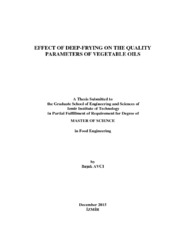Please use this identifier to cite or link to this item:
https://hdl.handle.net/11147/4569Full metadata record
| DC Field | Value | Language |
|---|---|---|
| dc.contributor.advisor | Tokatlı, E.Figen | - |
| dc.contributor.advisor | Özen, Fatma Banu | - |
| dc.contributor.author | Avcı, Başak | - |
| dc.date.accessioned | 2016-04-28T07:31:54Z | - |
| dc.date.available | 2016-04-28T07:31:54Z | - |
| dc.date.issued | 2015-12 | - |
| dc.identifier.citation | Avcı, B. (2015). Effect of deep-frying on the quality parameters of vegetable oils. Unpublished master's thesis, İzmir Institute of Technology, İzmir, Turkey | en_US |
| dc.identifier.uri | http://hdl.handle.net/11147/4569 | - |
| dc.description | Thesis (Master)--Izmir Institute of Technology, Food Engineering, Izmir, 2015 | en_US |
| dc.description | Full text release delayed at author's request until 2017.01.21 | en_US |
| dc.description | Includes bibliographical references (leaves: 85-90) | en_US |
| dc.description | Text in English; Abstract: Turkish and English | en_US |
| dc.description | xv, 112 leaves | en_US |
| dc.description.abstract | It was aimed to determine the changes in several chemical parameters, fatty acid composition and phenolic profiles of different types of olive oils (extra virgin, virgin, blended, refined) and sunflower oil in the deep-frying process. In addition, UV and FTIR spectroscopic data were collected during frying and they (UV, FTIR and the combination of FTIR and UV) were analyzed with multivariate statistical techniques (PCA, OPLS-DA and OPLS) to classify the oil samples and predict the chemical parameters. A domestic deep-fat electrical fryer was used to fry french fries for 4 minutes at 180ºC ten times without oil replenishment and oil samples were removed after 1st, 2nd, 3rd, 4th, 5th, 7th and 10th frying. Free fatty acid, peroxide value, K232, K270, total chloropyll and carotenoid contents, color, oxidative stability, total phenol content, total polar compounds, and fatty acid profiles of all oil samples and phenolics of extra virgin and virgin olive oils were determined. At the end of the tenth frying, no significant changes were detected in acidity, stability, and fatty acid compositions. Phenolic contents of extra virgin and virgin olive oils decreased after the fourth frying cycle. According to PCA and OPLS-DA results, UV spectra was able to discriminate oil samples. Chemical parameters, except peroxide value, were predicted with high accuracy by spectroscopic data. The fatty acids were predicted successfully with FTIR data, while the total phenol content was predicted by UV data with a higher R2 value. The combination of FTIR and UV spectra predicted the rest of the chemical measures in OPLS regression with a high accuracy. | en_US |
| dc.description.abstract | Bu çalışmada derin yağda kızartma işlemi sırasında değişik zeytinyağlarında ve ayçiçek yağında meydana gelen kimyasal değişiklerin belirlenmesi amaçlanmıştır. Ultraviyole ve Fourier dönüşümlü kızıl ötesi spektrometrelere ait verilerin (UV, FTIR) ve bu iki spektrumun birleşimi ile oluşan verilerin çok değişkenli istatistiksel yöntemlerle analizi ile (PCA, OPLS-DA, OPLS), kızartma işleminde kullanılan yağ örneklerinin sınıflandırılması ve bazı kimyasal parametrelerin tahmini de çalışılmıştır. Kızartmalık donmuş patates örnekleri, belirtilen yağların kullanılmasıyla (sızma, natürel, reviera ve rafine zeytinyağları ve ayçiçek yağı), ev tipi elektrikli bir fritözde 4 dakika boyunca, 180ºC de kızartılmış, işlemler, taze yağ eklenmeksizin, 10 kez tekrarlanmıştır. Serbest yağ asitliği, peroksit, K232, ve K270 değerleri, toplam klorofil ve karotenoid, oksidatif stabilite, toplam fenol, toplam polar madde miktarları ve yağ asitleri dağılımı bütün yağ örnekleri için, fenolik madde dağılımları ise sızma ve natürel zeytinyağları için belirlenmiştir. Onuncu kızartma işlemi sonunda, asitlik, stabilite ve yağ asidi dağılımlarında bir değişiklik bulunmamıştır. Sızma ve natürel zeytinyağlarında bulunan fenolik madde miktarlarında dördüncü kızartmalardan sonra bir azalma görülmüştür. Çok değişkenli istatistiksel modeller, ultraviyole verilerinin yağ örneklerinin sınıflandırmasında başarılı olduğunu göstermiştir. Peroksit sayısı dışındaki kimyasal parametreler spektroskopik veriler yardımı ile yüksek R2 değerleri ile tahmin edilebilmiştir. Yağ asitleri kompozisyonları FTIR verileri ile başarılı bir şekilde tahmin edilirken, Ultraviyole verilerinin toplam fenol miktarını tahmin etmede daha etkili olduğu görülmüştür. FTIR ve ultraviyole spektrumlarının birleşimi ile elde dilen veriler diğer kimyasal parametrelerin OPLS regresyon tekniği ile belirlenmesinde başarılı olmuştur. | en_US |
| dc.language.iso | en | en_US |
| dc.publisher | Izmir Institute of Technology | en_US |
| dc.rights | info:eu-repo/semantics/openAccess | en_US |
| dc.subject | Deep-frying process | en_US |
| dc.subject | Vegetable oils | en_US |
| dc.subject | Olive oil | en_US |
| dc.subject | Sunflower seed oil | en_US |
| dc.subject | Oils and fats, Edible | en_US |
| dc.title | Effect of Deep-Frying on the Quality Parameters of Vegetable Oils | en_US |
| dc.title.alternative | Derin Yağda Kızartma İşleminin Bitkisel Sıvı Yağların Kalite Parametreleri Üzerine Etkisi | en_US |
| dc.type | Master Thesis | en_US |
| dc.institutionauthor | Avcı, Başak | - |
| dc.department | Thesis (Master)--İzmir Institute of Technology, Food Engineering | en_US |
| dc.relation.publicationcategory | Tez | en_US |
| dc.identifier.wosquality | N/A | - |
| dc.identifier.scopusquality | N/A | - |
| item.openairecristype | http://purl.org/coar/resource_type/c_18cf | - |
| item.languageiso639-1 | en | - |
| item.openairetype | Master Thesis | - |
| item.grantfulltext | open | - |
| item.fulltext | With Fulltext | - |
| item.cerifentitytype | Publications | - |
| Appears in Collections: | Master Degree / Yüksek Lisans Tezleri | |
Files in This Item:
| File | Description | Size | Format | |
|---|---|---|---|---|
| T001432.pdf | MasterThesis | 3.81 MB | Adobe PDF |  View/Open |
CORE Recommender
Page view(s)
174
checked on Mar 31, 2025
Download(s)
232
checked on Mar 31, 2025
Google ScholarTM
Check
Items in GCRIS Repository are protected by copyright, with all rights reserved, unless otherwise indicated.